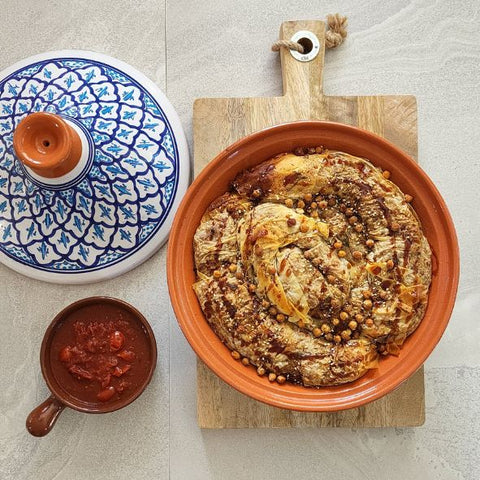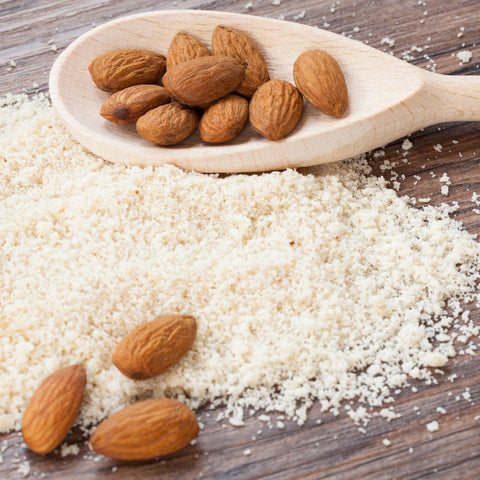What Is A Tagine:
A tagine (or Tajine) is a traditional earthenware cooking pot used to create slow-cooked meals and is used throughout North Africa, especially in Morocco, Tunisia, Libya & Algeria.
In these countries it's usually made with clay, however, if you have purchased one here in Australia then that would more than likely be made from ceramic material.
The most recognisable aspect of the tagine is its cone-shaped lid on top, it's this cone shape that helps to contain and recirculate steam around the dish, which allows the ingredients to cook evenly throughout. The slow cooking process allows the flavours to naturally combine together resulting in tender meat and infused vegetables creating an unforgettable healthy & hearty stew-like dish (also called Tagine).
The tagine pot is traditionally placed over hot coals or a low flame, but modern versions can be used on stovetops or in ovens and therefore we can all easily enjoy cooking with them any time of the week.

Using Your Tagine For The First Time:
I know your Tagine looks so beautiful that its good enough for an 'Exotic' kitchen decoration, but its time to conquer your fear of not using it incorrectly and finally use your tagine for its natural intended prupose.
To help I have created 8 steps to hopefully give you the confidence to make the most of out of your Tagine cooking experience from start to finish.
I will add that it's important to follow the manufacturer's instructions and guidelines specific to your tagine pot.
With proper care and use, your tagine will provide you with so many delicious North African meals.

My Top 8 Tips From Using To Creating A Moroccan Tagine:
-
Season the tagine: Before using your tagine for cooking, it's important to season it to improve its longevity and enhance the flavours of your dishes. This step is essential for clay or ceramic tagines. Soak the base and lid of the tagine in water for at least 2-3 hours or overnight. This helps to prevent cracking and allows the clay to absorb moisture. Then, remove the tagine from the water and let it air dry completely.
-
Prepare the ingredients: Choose a recipe that you would like to prepare in the tagine. You can head to our recipes & ideas page for some inspiration and of course for the sauce try our award-winning Morrocan Tagine Recipe base.Traditional tagines often feature meat or poultry along with vegetables and aromatic spices, but it's just as good if you're using veggies & legumes only. Cut your ingredients into pieces or slices as per your recipe.
-
Heat the tagine: Place a heat diffuser on the stovetop to distribute the heat evenly and to prevent the tagine from direct contact with the heat source. Place your tagine pot on top of the heat diffuser. This is also an important step to remember to protect your tagine from cracking.
-
Add the ingredients: Add a small amount of oil or butter to the base of the tagine and heat it gently. Then, add your prepared ingredients, starting with the meat or poultry. Brown the meat slightly to develop flavour. Next, add the veggies, and finally add your jar of Moroccan Tagine Recipe Base.
-
Cover and cook: Place the cone-shaped lid on the tagine, ensuring a tight fit. Remmebering that its the lid that helps to trap the steam, which allows the ingredients to cook slowly and evenly. Adjust the heat to low or medium-low and maintain a gentle simmer. Avoid high heat, as it can damage the tagine or cause it to crack.
-
Monitor and adjust: Check the tagine occasionally to make sure it is simmering gently. If needed, adjust the heat to maintain a steady simmer. It's important not to lift the lid frequently, as it can disrupt the cooking process and release steam.
-
Cooking time: The cooking time will depend on the recipe and the ingredients you're using. Tagines are known for slow cooking, so be prepared for a longer cooking time compared to other methods. The low and slow cooking process allows the flavours to develop and the meat to become tender.
-
Serve and enjoy: Once the dish is cooked to your desired doneness, carefully remove the tagine from the heat source. Remember that the pot will be hot, so use your oven gloves to handle. Allow the tagine to cool slightly before serving. Traditionally, tagines are brought directly to the middle of the table and served from the pot, creating a very attractive presentation.

Summary:
Using a Tagine is a wonderful addition to your kitchen cookware and an amazing way to create exotic North African flavours any day of the week.
Always read the manufacturer instructions for type of Tagine.
Remember to soak both the base and the lid for at least a minimum of 2 hours .
Use a heat diffuser to distribute the heat evenly whilst cooking.
Avoid using a high heat, always use a low (or medium) heat to cook slowly and evenly.
Be prepared for the slow cooking to take a little longer than usual and try not to lift the lid off too many times during the cooking process.
Enjoy your 'Exotic' creations in your new favourite kitchen cooking pot.
Try Our Award-Winning Exotic Moroccan Tagine Recipe Base





Comments (1)
Thank you for this information on using a tagine. Do I need to use a diffuser if using a gas cooktop?